
Phlox is a genus of 68 species of perennial and annual plants in the family Polemoniaceae. They are found mostly in North America in diverse habitats from alpine tundra to open woodland and prairie. Some flower in spring, others in summer and fall. Flowers may be pale blue, violet, pink, bright red, or white. Many are fragrant.

Oenothera caespitosa, known commonly as tufted evening primrose, desert evening primrose, rock-rose evening primrose, or fragrant evening primrose, is a perennial plant of the genus Oenothera native to much of western and central North America, in habitats such as talus slopes and sandy plains. It is normally night-blooming.
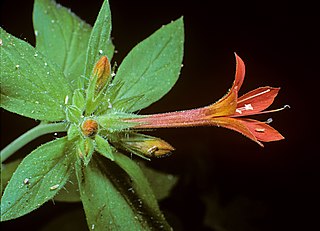
Collomia rawsoniana is a species of flowering plant in the phlox family known by the common name flaming trumpet. This perennial wildflower is endemic to California, where it is known from only two counties: Mariposa and Madera. It grows in the woodland understory in the Sierra Nevada foothills. This plant produces a thin, erect stem to about half a meter in height with widely spaced, deeply toothed hairy leaves each several centimeters long. Atop the stem is an inflorescence of three to seven showy red-orange flowers. Each flower is up to 4 centimeters long and trumpet-shaped, with a protruding pistil and stamens tipped with anthers covered in blue pollen.

Elymus glaucus is a species of grass known as blue wild rye or blue wildrye. This grass is native to North America from Alaska to New York to northern Mexico. It is a common and widespread species of wild rye.

Chorizanthe douglasii is a species of flowering plant in the buckwheat family known by the common names San Benito spineflower and Douglas' spineflower. It is endemic to California, where it grows in the mountains of the Southern California Coast Ranges, from the Santa Lucia Range east to the Gabilan Range.
Gilia diegensis is a species of flowering plant in the phlox family known by the common name coastal gilia.
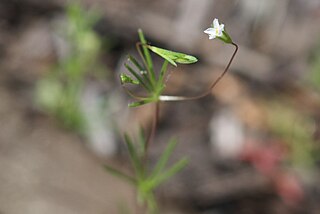
Leptosiphon harknessii is a species of flowering plant in the phlox family known by the common name Harkness' flaxflower.

Microseris douglasii is a species of flowering plant in the family Asteraceae known by the common name Douglas' silverpuffs. It is native to western North America from Oregon and California to Baja California. It grows in several types of habitat, including grassland and vernal pools, and on soils containing clay and serpentine.

Polemonium californicum is a species of flowering plant in the phlox family known by the common names moving polemonium, low Jacob's-ladder, and California Jacob's ladder. It is native to the northwestern United States, where it grows in shady and moist habitat, such as mountain woodlands. It is a hairy, glandular rhizomatous perennial herb forming clumps of several decumbent to erect stems 30 to 50 centimeters in maximum height. The leaves are up to 20 centimeters long and are compound, made up of several pairs of oval to lance-shaped leaflets. The leaflet at the tip of the leaf is often fused to the pair behind it. The inflorescence is a crowded cluster of bell-shaped flowers each up to 1.5 centimeters wide. The flower is blue or purple with a yellow center and a whitish tubular throat. The fruit is a capsule.

Phlox austromontana is a species of phlox known by the common name mountain phlox. It is native to the southwestern United States and Baja California, where it grows in forested and wooded mountain habitat, scrub, and open areas. It is a mat-forming perennial herb growing in patches of very short stems. The lance-shaped leaves are no more than 1.5 centimeters long and are arranged oppositely in pairs on the short stems. The inflorescence is a solitary flower at the tip of each stem. The flower is white or light pink or lavender with five rounded lobes. It is just over a centimeter long.

Phlox diffusa is a species of phlox known by the common name spreading phlox. It is native to western North America from British Columbia to the southwestern United States to the Dakotas, where it grows in many types of habitat, including rocky, high elevation mountain slopes. It is a very compact mat-forming perennial herb growing in cushions or patches of short, decumbent stems. The linear, lance-shaped, or needle-like leaves are no more than 1.5 centimeters long and are oppositely arranged in bundles on the short stems. The inflorescence is a solitary tubular flower around a centimeter long. It has a flat white or pale pink or blue corolla with five lobes each just under a centimeter in length.
Phlox dolichantha is a species of phlox known by the common name Big Bear Valley phlox. It is endemic to San Bernardino County, California, where it is limited to the area around Big Bear Lake in the San Bernardino Mountains. It grows in forests and the unique local pebble plain habitat. It occurs at elevations over 2000 meters. It is an erect, branching perennial herb growing up to 30 centimeters tall. The linear or narrowly lance-shaped leaves are 2 to 5 centimeters long and are oppositely arranged on the slender stems. The inflorescence is made up of one or more showy flowers at the tip of the stem. Each flower has a very slender tubular throat up to 5 centimeters long which can be white, pink, or lavender.

Microsteris is a monotypic genus of flowering plants in the phlox family containing the single species Microsteris gracilis, known by the common name slender phlox.
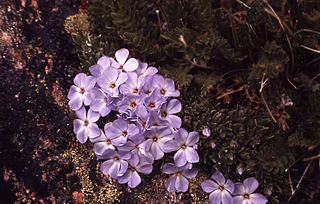
Phlox pulvinata is a species of phlox known by the common name cushion phlox. It is native to the western United States where it grows in mountain and plateau habitat, in rocky subalpine and alpine climates, including exposed tundra habitat. It is a perennial herb taking a flat, dense, cushionlike form on the ground. Its very short stems are lined with hair-fringed lance-shaped leaves each no more than one centimeter long. The plant is among the first to flower in the spring in many areas. It blooms densely, forming carpets of flowers. Each white to pale pink flower has a tubular throat up to one centimeter long and a flat five-lobed corolla.
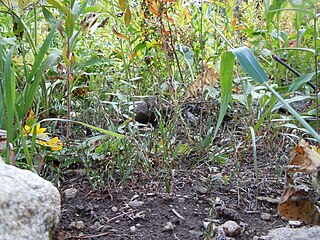
Polygonum douglasii is a species of flowering plant in the knotweed family known by the common name Douglas's knotweed. It is native to much of northern and western North America, where it can be found in many types of habitat, including disturbed areas. It has been found in Canada from British Columbia north to Yukon and east as far as Québec, and in the United States as far south as California, New Mexico, Iowa, and New York.

Silene douglasii is a species of flowering plant in the family Caryophyllaceae known by the common name Douglas's catchfly.
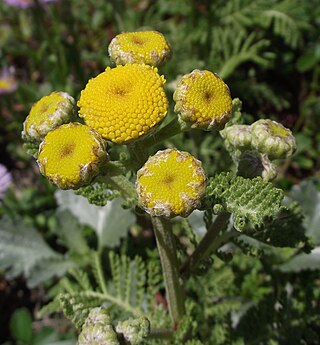
Tanacetum camphoratum is a species of flowering plant in the aster family known by the common names camphor tansy and dune tansy. It is native to the Pacific Coast of North America from British Columbia to California, where it grows in sand dunes and other coastline habitat. This species may be known by the synonym Tanacetum douglasii and is often included in Tanacetum bipinnatum. It is a rhizomatous perennial herb with a thick, low-lying stem up to 25 centimeters long, branching to form a mass of vegetation. It is hairy, glandular, and aromatic, with a camphor scent. The leaves are up to 25 centimeters long and thick but featherlike, divided into many narrow leaflets on each side of the main rachis. Each leaflet in turn has many segments along each side, and the segments are usually divided into several small, knobby segments with folded or curled edges. The inflorescence bears up to 15 flower heads, each about a centimeter wide or slightly wider. Each head contains many yellowish disc florets and many pistillate florets around the edges. The latter may have minute ray florets. The fruit is an achene a few millimeters long which is tipped with a small pappus of toothed scales.

Aliciella caespitosa is a species of flowering plant in the phlox family known by the common names Rabbit Valley gilia and Wonderland Alice-flower. It is endemic to Utah, where it is known only from Wayne County.
Polemonium pectinatum is a species of flowering plant in the phlox family known by the common names Washington Jacob's-ladder and Washington polemonium. It is endemic to the state of Washington in the United States, where it occurs in the Columbia Basin, including the Channeled Scablands and the Palouse.

Phlox douglasii, common name tufted phlox or Columbia phlox, is a species of perennial herb belonging to the family Polemoniaceae. In the past it has been mistakenly included within the species Phlox caespitosa.

















